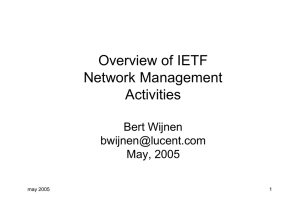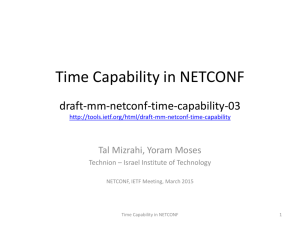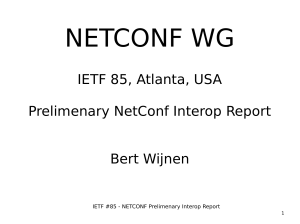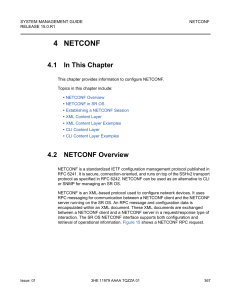O Adaptive Resilient Tactical Network Management
advertisement
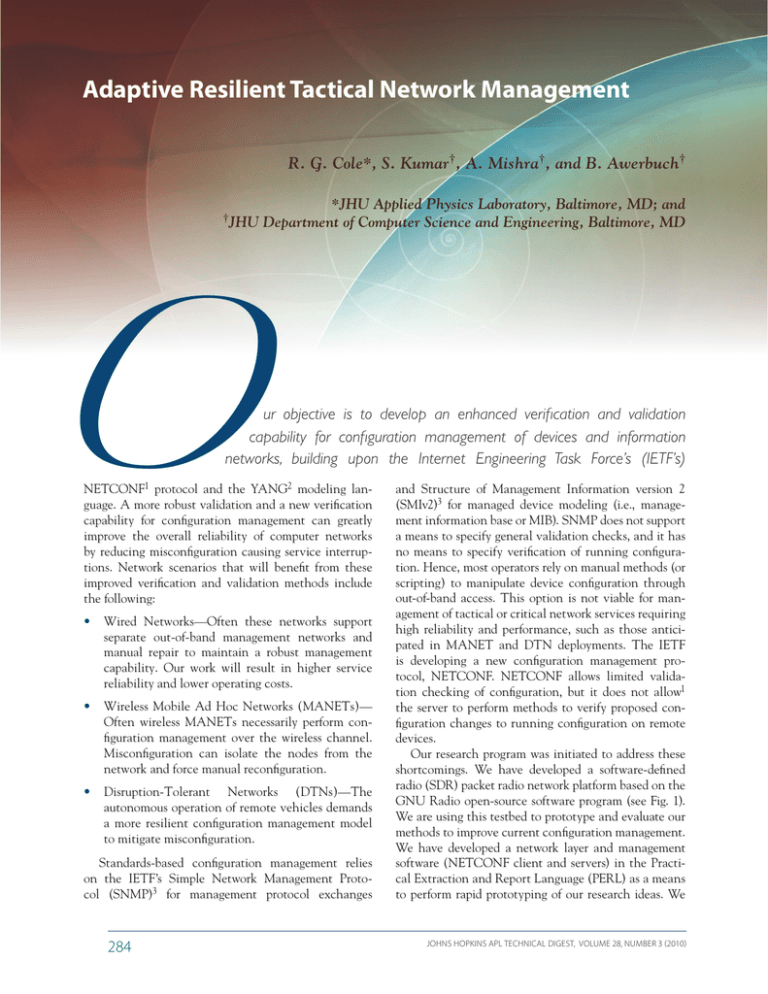
O Adaptive Resilient Tactical Network Management †JHU R. G. Cole*, S. Kumar†, A. Mishra†, and B. Awerbuch† *JHU Applied Physics Laboratory, Baltimore, MD; and Department of Computer Science and Engineering, Baltimore, MD ur objective is to develop an enhanced verification and validation capability for configuration management of devices and information networks, building upon the Internet Engineering Task Force’s (IETF’s) NETCONF1 protocol and the YANG2 modeling language. A more robust validation and a new verification capability for configuration management can greatly improve the overall reliability of computer networks by reducing misconfiguration causing service interruptions. Network scenarios that will benefit from these improved verification and validation methods include the following: • Wired Networks—Often these networks support separate out-of-band management networks and manual repair to maintain a robust management capability. Our work will result in higher service reliability and lower operating costs. • Wireless Mobile Ad Hoc Networks (MANETs)— Often wireless MANETs necessarily perform configuration management over the wireless channel. Misconfiguration can isolate the nodes from the network and force manual reconfiguration. • Disruption-Tolerant Networks (DTNs)—The autonomous operation of remote vehicles demands a more resilient configuration management model to mitigate misconfiguration. Standards-based configuration management relies on the IETF’s Simple Network Management Protocol (SNMP)3 for management protocol exchanges 284 and Structure of Management Information version 2 (SMIv2)3 for managed device modeling (i.e., management information base or MIB). SNMP does not support a means to specify general validation checks, and it has no means to specify verification of running configuration. Hence, most operators rely on manual methods (or scripting) to manipulate device configuration through out-of-band access. This option is not viable for management of tactical or critical network services requiring high reliability and performance, such as those anticipated in MANET and DTN deployments. The IETF is developing a new configuration management protocol, NETCONF. NETCONF allows limited validation checking of configuration, but it does not allow1 the server to perform methods to verify proposed configuration changes to running configuration on remote devices. Our research program was initiated to address these shortcomings. We have developed a software-defined radio (SDR) packet radio network platform based on the GNU Radio open-source software program (see Fig. 1). We are using this testbed to prototype and evaluate our methods to improve current configuration management. We have developed a network layer and management software (NETCONF client and servers) in the Practical Extraction and Report Language (PERL) as a means to perform rapid prototyping of our research ideas. We JOHNS HOPKINS APL TECHNICAL DIGEST, VOLUME 28, NUMBER 3 (2010) ADAPTIVE RESILIENT TACTICAL NETWORK MANAGEMENT Managed Devices NETCONF Servers NETCONF Client Node Node 192.168.0.209/24 192.168.0.207/24 Node (900 MHz and 2.4 GHz frequency bands) 192.168.0.208/24 Node 192.168.0.206/24 Management Application Node NETCONF Client 192.168.0.210/24 Linux Server (Ubuntu) Software Defined Radio ARTNM Perf. Mgmt Application Current Research and Prototype Focus New config <edit-conf> w/target :candidate [ok] Execute change Antenna USB NETCONF Server <start-verified-commit> w/source :candidate w/timeout w/test-template :instanceID w/notify-me true [ok] ETTUS HW Multiple transceivers, baseband conversion, A/D conversion ARTNM Net. Mgmt Application UDP TCP IP GNU Radio MAC Wireless Physical Layer Standard TCP/IP Applications Standard Sockets Interface Ethernet Interface (gr0; GNU Radio tunnel.py interface) (Software Defined Radio) Cancel change Server status no change Build :candidate config Copy :candidate to :running config Start timer Execute tests Test complete failed! <verifiedCommitStatus = bad> notification <cancel-verified-commit> Timer expired! Backout of change to :previous-config Figure 2. Example of robust verify and backup. Figure 1. GNU Radio prototyping network. have developed and prototyped the following improved methods: • Generalized validation checking through syntax, constraints, and policy documents • Generalized verification testing by explicitly involving the managed device and defining means to specify the verification tests and associated acceptance criteria • Generalized verification testing by defining methods that allow simultaneous network-wide configuration management Figure 2 shows an example of our more robust configuration management capabilities. Here the client requests that the server (the remote managed device) reconfigure aspects of its network interface and follow up with a set of active measurements to determine the correctness of the new configuration. The server reports these results back to the client, which is responsible for issuing the final commit to the server. In the event of failure of measurements, or failure of connectivity, the server is designed to always back out to the previous correct state. This process is illustrated at the bottom of the diagram in Fig. 2. We will continue our experiments and investigations of this new technology. Future focus areas include developing more autonomy in remote device management; new, network-wide, upgrade capabilities; and more efficient transport and operations bundling for operations over DTN networks. For further information on the work reported here, see the references below or contact robert.cole@jhuapl.edu. 1Enns, R., (ed.), NETCONF Configuration Protocol, Internet Engineering Task Force (IETF) RFC 4741, http://rfc-editor.org/cgi-bin/ rfcdoctype.pl?loc=RFC&letsgo=4741&type=http&file_format=pdf (Dec 2006). 2Presuhn, R., Case, J., McCloghrie, K., Rose, M., and Waldbusser, S., Version 2 of the Protocol Operations for the Simple Network Management Protocol (SNMP), Internet Engineering Task Force (IETF) RFC 3416, http://rfc-editor.org/cgi-bin/rfcdoctype.pl?loc= RFC&letsgo=3416&type=http&file_format=pdf (Dec 2002). 3McCloghrie, K., Perkins, D., and Schoenwaelder, J., Structure of Management Information Version 2 (SMIv2), Internet Engineering Task Force (IETF) RFC 2578, http://rfc-editor.org/cgi-bin/rfcdoctype.pl?loc=RFC&letsgo=2578&type=http&file_format=pdf (Apr 1999). JOHNS HOPKINS APL TECHNICAL DIGEST, VOLUME 28, NUMBER 3 (2010) 285­­
